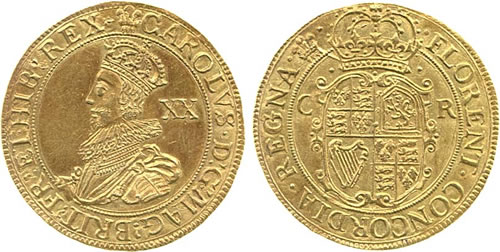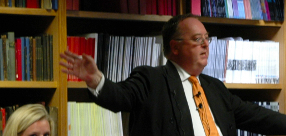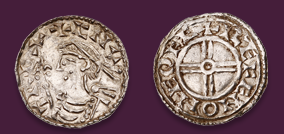
Auction: 3024 - The Slaney Collection of English Coins
Lot: 13
Charles I, Proof Unite, 9.05g., Tower mint, group C, class I, bust 3, third bust with ruff and armour, wearing crown 3c similar to crown 3b on the late issues of group B, carolus d g mag brit fr et hib rex, rev. oval garnished shield with cr at sides, florent concordia regna, m.m. plume (Schneider 134 (same obv. die) and BNJ 1957 p.368, footnote 1 (this coin); N.2150, footnote 99), deeply toned, in proof mint state, extremely rare Estimate £4,000-5,000 provenance:
J B Bergne, Sotheby, 20 May 1873, lot 810
J Halliburton Young, Sotheby, 7 April, 1881, lot 232
J E Bieber, Sotheby, 13 May 1889, lot 132
A B Richardson, Sotheby, 22 May 1895, lot 193
Henry Clark, Sotheby, 23 May 1898, lot 205
V J E Ryan, Glendining, 28 June 1950, lot 445
Basmadjief, Glendining, 15 July 1953, lot 50
The issue of group C unites was the most intricate and erratic of the reign of Charles I (BNJ 1957 p.341-3) and contains an unusual number of pattern, proof and 'model' strikings. The pattern for the type (N.2666) was prepared during the period of mintmark heart, 26 June 1629 to 23 June 1630, and group C was introduced early in 1631. However around the beginning of 1631 the king changed his style of dress, replacing the stiff ruff "picardil" with a soft falling lace collar. A new pattern was produced (N.2667) before the end of June 1631, bearing mintmark plume but anticipating the portrait of group D, adopted after 21 June 1632. This rendered the group C portrait obsolete very early in the issue and the design of the unites appears to have remained in an experimental stage.
In addition Nicholas Briot, employed from 1626 to engrave the royal effigy as a service to the mint engravers, appears to have prepared a number of carefully executed "model" coins to enable the Tower engravers and workmen "thereby to conform their work together" while he was preoccupied in the run up to his first milled coinage of 1631-2.
The 'model' strikings are not true proofs, indeed the above coin is struck from the only set of proof dies specifically indentified as such by Schneider. It bears exactly the same portrait, made with the same master punches, as the group C pattern mintmark harp. Only a very few coins with this bust, bust 3, are known either as proof or currency strikings and it was very soon replaced by the larger bust 3a. The proof reverse die is easily identified by the raised line which extends from the base of the mintmark to the band of the crown. Not all coins die-linked into the proof or "model" strikings are necessarily of this standard. Schneider 134 is struck from the proof obverse die combined with a normal reverse die and it is not unusual to find proof or "model" dies released for general use where they produce coins of finer than usual, but not 'prooflike', quality.
Sold for
£11,000




